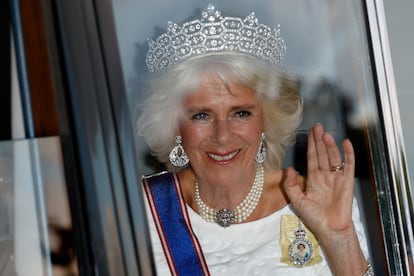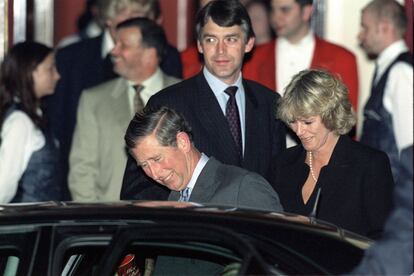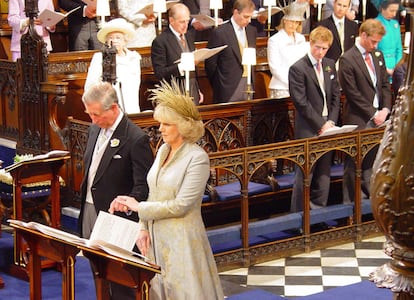Elizabeth II’s last gift to her son
Before her death, the British monarch wanted to resolve the position of the hitherto Duchess of Cornwall. Now, after 70 years, the United Kingdom has a Queen Consort again.

This past February, Elizabeth II ended more than two decades of uncertainty about her daughter-in-law’s position within the British royal family.
“When, in the fullness of time, my son Charles becomes King, I know you will give him and his wife Camilla the same support that you have given me; and it is my sincere wish that, when that time comes, Camilla will be known as Queen Consort as she continues her own loyal service,” the monarch announced in a brief statement, issued as part of the celebrations for her Platinum Jubilee.
Under common law, the wife of a British King is always known as Queen Consort, while husbands of queens are only Prince Consorts. Philip of Mountbatten, husband of Elizabeth II, for example, had to be content with the title of Duke of Edinburgh.
Despite the centuries-old tradition, however, Camilla’s new title is still novel: the UK hasn’t had a Queen Consort for 70 years. The last was the mother of Elizabeth II herself, who was given the title after her marriage to King George VI. The title was withdrawn after his death in 1952. From then on, until her death in 2002, she was known as Queen Mother.
Doubts about Camilla’s position in the House of Windsor date back to January of 1999, when the then-Prince of Wales and his girlfriend made their first public appearance as a couple at the Ritz hotel in London. Diana of Wales had died only two years earlier – much of British society didn’t approve of the relationship between the heir to the throne with a divorced woman and mother of two children from a previous marriage. In fact, six years had to pass before Charles and Camilla could marry, with the approval of Elizabeth II. On April 9, 2005, they said “I do” in a discreet civil ceremony. The Queen and her husband, the Duke of Edinburgh, did not attend the event, but were present at the subsequent mass. They also offered a reception for the newlyweds at Windsor Castle.

According to reports in the British press, there was the possibility that Camilla would have become “Princess Consort” – the first in the history of the monarchy. Ultimately, it was agreed that she would receive the title of Duchess of Cornwall, in keeping with the Duchy of Cornwall, a distinction always given to heirs to the British throne. Any other title would have been risky at the time, when even the very validity of the marriage was in question. According to the Marriage Act of 1753, the only valid kind of union for a member of the British royal family is a religious one. The Lord Chancellor – a senior UK government official – and the Archbishop of Canterbury – head of the Church of England and spiritual leader of the Anglican Communion – even had to publicly come out in defense of the marriage.
“It was not easy,” the Duchess of Cornwall herself acknowledged in an interview in the British edition of Vogue, recently published on the occasion of her 75th birthday. “I was tested for so long and I had to find a way to live with it. Nobody likes to be looked at all the time [or] criticized ... but in the end, somehow, I got over all that and moved on.”

Camilla’s position within the royal family was never a big concern for Charles, but according to those close to him, it was “something he wanted to address” with his mother before it was too late. The statement that Elizabeth II issued in February – just a few months before her death on September 8 – was the result of conversations with her heir and proof of a consensus between the two. But it was also the way in which the monarch chose to thank her daughter-in-law for her loyalty, patience and years of service to the crown. In June, Elizabeth II went a step further, making her a Royal Lady of the Order of the Garter, the UK’s oldest and highest-ranking institution.
In recent years, Camila’s popularity has grown dramatically, with both the public and her mother-in-law. She may never be “queen of hearts,” as Diana of Wales was… but she is now Queen Consort of the United Kingdom.

Tu suscripción se está usando en otro dispositivo
¿Quieres añadir otro usuario a tu suscripción?
Si continúas leyendo en este dispositivo, no se podrá leer en el otro.
FlechaTu suscripción se está usando en otro dispositivo y solo puedes acceder a EL PAÍS desde un dispositivo a la vez.
Si quieres compartir tu cuenta, cambia tu suscripción a la modalidad Premium, así podrás añadir otro usuario. Cada uno accederá con su propia cuenta de email, lo que os permitirá personalizar vuestra experiencia en EL PAÍS.
¿Tienes una suscripción de empresa? Accede aquí para contratar más cuentas.
En el caso de no saber quién está usando tu cuenta, te recomendamos cambiar tu contraseña aquí.
Si decides continuar compartiendo tu cuenta, este mensaje se mostrará en tu dispositivo y en el de la otra persona que está usando tu cuenta de forma indefinida, afectando a tu experiencia de lectura. Puedes consultar aquí los términos y condiciones de la suscripción digital.
Últimas noticias
The complicated life of Francesca Albanese: A rising figure in Italy but barred from every bank by Trump’s sanctions
How Japan is trying to avert ‘digital defeat’
Half of Scotland is in the hands of 420 property owners
Reinhard Genzel, Nobel laureate in physics: ‘One-minute videos will never give you the truth’
Most viewed
- Pablo Escobar’s hippos: A serious environmental problem, 40 years on
- Why we lost the habit of sleeping in two segments and how that changed our sense of time
- Charles Dubouloz, mountaineering star, retires at 36 with a farewell tour inspired by Walter Bonatti
- Reinhard Genzel, Nobel laureate in physics: ‘One-minute videos will never give you the truth’
- The Florida Keys tourist paradise is besieged by immigration agents: ‘We’ve never seen anything like this’









































